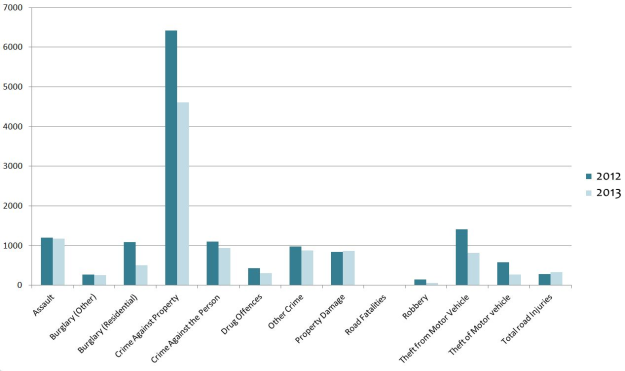
City of Nairobi
This is an open letter to the Honourable Joseph ole Lenku, the Cabinet Secretary of the Ministry of Interior, and Hon. Evans Kidero, the Governor of Nairobi.
Our capital city’s erstwhile reputation as the Green City in the Sun has been damaged largely by decades of dreadful management, wanton lack of oversight and, overall, systematic neglect of its own by-laws.
The city has defied this decay and is slowly but surely emerging as a financial and tech hub in Africa. A growing middle class, vibrant financial markets, fairly educated workforce and a construction boom have now become synonymous with eastern Africa’s largest city.
Often, when the general public talks of a ‘modern’ city, it is glistening high-rise buildings, advanced road networks, gargantuan shopping malls and dazzling night life that almost instinctively come to mind. Rarely, if ever, will crime and a total breakdown of order come to mind.
Yet, my strong feeling is that with the profile that it is increasingly gaining, Nairobi requires that the authorities concerned look at how we can better employ security resources. Here are a few ideas, within the realm of law and order, that this post was intended to share for your consideration.
1. Outsource Traffic Surveillance
In a country deficient of the recommended number of law enforcers required to effectively forestall runaway crime, it goes without saying that we need more policemen and policewomen deployed in mainstream crime prevention duties. My radical suggestion is that Nairobi outsources traffic surveillance to a top private security firm.
The firm would invest in surveillance cameras that have both number-plate recognition and night vision capabilities (they exist!). The cameras would be used to remotely monitor the city’s major roads and highways, particularly those notorious for gridlocks.
From the security firm’s central monitoring centre, their officers would look out for and capture evidence in real  time of drivers flouting traffic laws like in cases of overlapping, obstructing, jumping traffic lights and dropping off passengers in non-designated areas. The police would then be presented with the incriminating evidence for follow up and the security firm paid a pre-determined percentage from the resulting fines.
time of drivers flouting traffic laws like in cases of overlapping, obstructing, jumping traffic lights and dropping off passengers in non-designated areas. The police would then be presented with the incriminating evidence for follow up and the security firm paid a pre-determined percentage from the resulting fines.
In fact, a law can even be enacted to make it mandatory for insurers to recover the fines from offending car owners, on behalf of government, as a pre-condition for insurance renewal. Moreover, in case of a motor accident, the security firm would be able to quickly tip-off the police to the scene.
Of course, the biggest loser in such an arrangement would be the glaring impunity embodied by the unscrupulous traffic police officer who is wont to pocket bribes that otherwise are revenues that rightfully belong in the public coffers. Thus in considering implementing such a plan, change management on the part of the Kenya Police Service would be vital for the overall project’s success. But the biggest winner, ultimately, would be the ordinary mwananchi.
Some countries such as South Africa have traffic marshalls who complement law enforcement officers in tracking traffic offenders. Like bounty hunters, they are rewarded through commissions paid off fines. Moreover, the surveillance infrastructure in Johannesburg is managed by the city’s business community and manned by rehabilitated former thugs.
Apart from minor legal enactment encumbrances, I see few challenges in outsourcing traffic surveillance. In fact, the BOT (build, operate, transfer) model of project financing would be perfect! In such an instance, the city government can take over the monitoring infrastructure after a given period of time within which the security firm would have recouped its investment.
2. Modernise Traffic Lights
 I cannot remember the last time Nairobi was lucky to have a well-meaning chief executive like Governor Evans Kidero. He has cited traffic management as one of his priorities and I hope he gets the necessary support to modernize Nairobi’s derelict traffic lights systems.
I cannot remember the last time Nairobi was lucky to have a well-meaning chief executive like Governor Evans Kidero. He has cited traffic management as one of his priorities and I hope he gets the necessary support to modernize Nairobi’s derelict traffic lights systems.
His government may want to borrow from Mumbai City which, backed by the World Bank, and reeling from chocking traffic, deployed camera-assisted, cutting edge traffic lights systems that featured, among other capabilities, real time adjustments. So if Nairobi were to outsource traffic surveillance as afore-described, the same cameras can also be used to aid in the management of traffic lights.
Many traffic lights systems today are be equipped with Wifi or GSM modems which eliminate the need to lay down underground communication cables for remote traffic management.
3. Recruit Local Law Enforcers
Growing up in Nairobi’s Buru Buru in the 1980s and early 1990s, my contemporaries and I knew many of the louts in the neighbourhood and adjoining residential estates, where they attended school, their inner-estate hangout lair (maskan, we called it), siblings, close friends, sometimes even their parents. Whenever anything anti-social occurred, we had a fairly good hunch of who the culprits were. Often, they were.
I yearn for the day when the Kenya Police Service and County Government would consider a Metropolitan force whose law enforcement teams would be drawn from the suburbs. Think about it, if you grew up in a certain locality and were familiar with the residents, wouldn’t you be more effective in helping crack down on the bad elements? Wouldn’t residents be more motivated to embrace community policing if they worked closely with familiar faces and age-old pals?
For this to happen, the authorities could come up with a metropolitan policing policy that requires, say, 60% of officers in a police station to be drawn from that very locality.
It is no secret that residents are more familiar with the rogue elements in their neighbourhood. When, in the late 90s, I was a member of the Rotaract movement, we made regular visits to the Mathare-based Good Samaritan Children’s Home, which we supported at the time. As we trudged through the valley after an afternoon of playing and hanging out with the kids, the older ones escorting us would often furtively point out to us some of the bad guys in the sprawling slum.
“That guy is known to harbour and sell guns”, they whispered to us. “See this other guy”, another kid volunteered, “he is the local mungiki commandant. He rakes in extortion money daily from shop owners”.
The point? What better way to implement community policing than by having police stations in crime-prone areas manned by qualified, trusted locals who grew up in the same area they are serving?
4. Basic Automation For Police Stations
Currently, when one has an incident to report at a police station, the officer at the reporting desk would record your statement on a usually threadbare Occurrence Book (OB) and, once done, hand you the OB reference number written on a piece of paper.
I believe headquarters lacks a graphical or statistical mechanism of tracking, using a portal or database, in real time, the locality where a case has been lodged, the frequency and category of crimes reported, etc.
Undoubtedly such information would help the force come up with rapid counter-measures quickly, besides assist them in strategic planning.
It would be my wish to have each police station equipped with a hand-held PDQ device. These are typically hardy, can work anywhere served by a mobile network and can be instrumental in logging and transmitting statistics, in near real-time, to a centralized intelligence-gathering portal.
The software installed in the PDQ, which relays data using normal GSM SIM cards, would have various categories of crimes. So if one made a report of, say, a carjack, the officer at the reporting desk would, after recording the statement, enter the details of the crime on a PDQ, including details of the specific road in which the crime occurred, plus the victim’s ID number or equivalent. The PDQ (some of them support biometrics) would then generate a report receipt with the OB reference number which can be handed to the victim.
In the meantime, away from the police station, the crime dashboard, which can be made available on a publicly accessible portal, would instantaneously be updated with details of this particular incident. A number of local technology firms are known to program and support these kind of PDQs and therefore there is local capacity to support them. Indeed, some of the PDQs support solar charging and can operate for several days without the need for battery recharge.
With such an open system, investors can access crime statistics of various locations, neighbourhood associations and ordinary citizens can readily access the information and take measures to improve their security or even lend in useful information that can be used to nab suspects. Additionally, if statistics pointed to an upsurge of carjacking incidents in a certain area, headquarters can make informed decisions to deploy more patrol vehicles or step up foot patrols.

If a certain locality, on the other hand, registers a disproportionately high amount of female rape cases, the police chiefs would be better advised to deploy more policewomen, and so on.
Of course, there are more ways in which the technology could be improved including being able to compile weekly crime reports to county neighbourhood associations, alerting security guards and on-patrol officers via SMS, etc.
Granted, there are, overall, many interventions – some indeed basic – required to boost security and order. The now moribund 999 emergency number should be made to work reliably at all times, the welfare and proper equipping of police officers needs to be urgently looked into and residents should be enlightened on the various ways in which they can act as first line of deterrence.
But even as we focus on the basics, it is my hope that the authorities concerned can consider incorporating the foregoing (similarly basic) tips as necessary in endeavours to improve enforcement of law and order. It is instructive that implementation of some of the ideas shared would be good candidates for public-private partnerships. Both the Constitution and Vision 2030 blueprint contemplate closer partnerships not only between citizenry and Government but also between Government and private sector.
As the city surges ahead with its rapid modernisation and increasing sophistication of her residents, its law enforcement agencies should not be left behind.
Useful References
a. Why Government Should Outsource Technology
http://www.slate.com/articles/technology/future_tense/2013/02/fiberwan_terry_childs_gavin_newsom_on_why_governments_should_outsource_technology.html
b. Municipalities Need To Outsource In 2013
http://outsourcing.about.com/od/clouds/a/Municipalities-Need-To-Outsource-In-2013.htm
c. Mumbai Introduces Modern Traffic Management System
http://web.worldbank.org/WBSITE/EXTERNAL/COUNTRIES/SOUTHASIAEXT/0,,contentMDK:22938853~menuPK:158842~pagePK:2865106~piPK:2865128~theSitePK:223547,00.html
Twitter: @fkariuki



 time of drivers flouting traffic laws like in cases of overlapping, obstructing, jumping traffic lights and dropping off passengers in non-designated areas. The police would then be presented with the incriminating evidence for follow up and the security firm paid a pre-determined percentage from the resulting fines.
time of drivers flouting traffic laws like in cases of overlapping, obstructing, jumping traffic lights and dropping off passengers in non-designated areas. The police would then be presented with the incriminating evidence for follow up and the security firm paid a pre-determined percentage from the resulting fines. I cannot remember the last time Nairobi was lucky to have a well-meaning chief executive like Governor Evans Kidero. He has cited traffic management as one of his priorities and I hope he gets the necessary support to modernize Nairobi’s derelict traffic lights systems.
I cannot remember the last time Nairobi was lucky to have a well-meaning chief executive like Governor Evans Kidero. He has cited traffic management as one of his priorities and I hope he gets the necessary support to modernize Nairobi’s derelict traffic lights systems.
